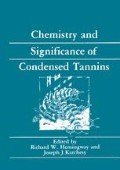Abstract
Past efforts aimed at replacing the phenolic material in wood adhesives by tannins of various origins have been extensive throughout the world, with research activity normally paralleling the price of phenol. With the exception of the use of “wattle” tannins for both thermosetting and cold-setting wood adhesives primarily in South Africa, success has been limited. More recent attempts (during the past 5 years) carried out in the United States to develop cold-setting wood adhesives for end-jointing and laminating lumber for structural applications requiring exterior glueline quality indicate substantial promise for the use of conifer tree barks as partial substitutes for resorcinol. These tannin-based, cold-setting adhesive formulations include an adhesive blend to be applied as a one-component system and a two-component “Honeymoon” system, each of which has been formulated either as face-laminating or end-jointing adhesives. In most formulations, half the resorcinol has been replaced by tannins extracted from the bark of southern pine trees.
Access this chapter
Tax calculation will be finalised at checkout
Purchases are for personal use only
Preview
Unable to display preview. Download preview PDF.
References
Pizzi, A Tannin-based adhesives. In: Pizzi, A. (ed). Wood Adhesives: Chemistry and Technology. Marcel Dekker, New York pp. 177–246 (1983).
Pizzi, A. Tannin-based adhesives. J. Macromol. Sci. Rev. Macromol. Chem. C18: 247 (1980).
Ayla, C.; Weissmann, G. New developments in the use of tannin formaldehyde resins for the manufacture of partideboard. Plant Res. Develop. 19: 107 (1984).
Hall, J.A. Utilization of Douglas-fir bark. Pacific Northwest Forest and Range Experiment Station, USDA Forest Service, Portland, Oregon. Misc. Rept. 138 p. (1971).
Hemingway, R.W. Significance of Condensed Tannins In: Rowe, J.W. (ed.). Natural Products Extraneous to the Lignocellulosic Cell Wall of Woody Plants. Springer Verlag, New York (in press).
Herrick, F.W. Chemistry and utilization of western hemlock bark extractives. J. Agric. Food Chem. 28: 228 (1980).
Roux, D.G.; Ferreira, D.; Hundt, H.K.L.; Malan, E. Structure, stereochemistry, and reactivity of natural condensed tannins as basis for their extended industrial application. J. Appl. Polym. Sci. Polym. Symp. 28: 335 (1975).
Pizzi, A.; Rossouw, D. duT.; Knuffel, W.E.; Singurin, M. `Honeymoon’ phenolic and tannin-based fast-setting adhesive systems for exterior grade finger joints. Holzforsch. und Holzverwer. 32: 140 (1980).
Baxter, G.F.; Kreibich, R.E. A fast-curing phenolic adhesive system. For. Prod. J. 23: 17 (1973).
Kreibich, R.E. High-speed adhesives for the wood gluing industry. Adhesives Age 17: 26 (1974).
Hemingway, R.W.; Kreibich, R.E. Condensed tannin-resorcinol adducts and their use in wood-laminating adhesives: an exploratory study. J. Appl. Polym. Sci. Polym. Symp. 40: 79 (1984).
Hemingway, R.W.; McGraw, G.W.; Laks, P.E.; Kreibich, R.E. Condensed tannins. Problems and prospects for their extended use in wood adhesives. In: Christiansen, A.W.; Gillespie, R.H.; Meyers, G.E.; River, B.H. (eds.) Wood Adhesives in 1985: Status and Needs. Forest Products Research Society, Madison, Wisconsin, p. 156–166 (1986).
Kreibich, R.E.; Hemingway, R.W. Condensed tannins: resorcinol adducts in laminating adhesives. For. Prod. J. 35: 23 (1985).
Hemingway, R.W.; Lloyd, R.C. Economic prospects for conifer bark extracts. Southern Forest Experiment Station, USDA Forest Service, New Orleans, Louisiana. Final Report No. FS-SO-3201–47. (1983).
Foo, L.Y.; McGraw, G.W.; Hemingway, R.W. Condensed tannins: preferential substitution at the interflavanoid bond by sulfite ion. J. Chem. Soc. Chem. Commun. 12: 672 (1983).
McGraw, G.W.; Laks, P.E.; Hemingway, R.W. Condensed tannins: desulfonation of hydroxybenzylsulfonic acids related to proanthocyanidin derivatives. J. Wood Chem. Technl. 8: 91 (1988).
Kreibich, R.E.; Hemingway, R.W. Condensed tannin-sulfonate derivatives in cold-setting wood-laminating adhesives. For. Prod. J. 37: 43 (1987).
Kreibich, R.E.; Hemingway, R.W. Tannin-based adhesives for finger-jointing wood. In: Hemingway, R.W.; Conner, A.H.; Branham, S.J. (eds.) Adhesives from Renewable Resources. American Chemical Society, Washington DC, pp. 203–216 (1989).
Author information
Authors and Affiliations
Editor information
Editors and Affiliations
Rights and permissions
Copyright information
© 1989 Plenum Press, New York
About this chapter
Cite this chapter
Kreibich, R.E. (1989). Tannin-Based Wood Adhesives. In: Hemingway, R.W., Karchesy, J.J., Branham, S.J. (eds) Chemistry and Significance of Condensed Tannins. Springer, Boston, MA. https://doi.org/10.1007/978-1-4684-7511-1_29
Download citation
DOI: https://doi.org/10.1007/978-1-4684-7511-1_29
Publisher Name: Springer, Boston, MA
Print ISBN: 978-1-4684-7513-5
Online ISBN: 978-1-4684-7511-1
eBook Packages: Springer Book Archive

